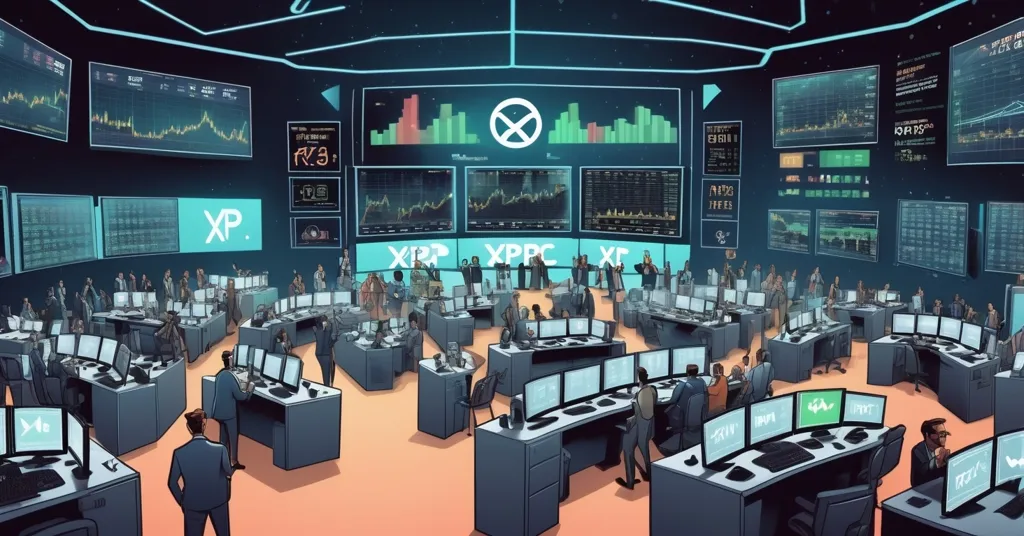XRP Spot ETF Launches in U.S.: Breakthrough for Crypto or Hype Overdrive?

XRP Spot ETF Goes Live in the U.S.: A Turning Point or Just Another Hype Cycle?
Canary Capital has just launched the first 100% spot exchange-traded fund (ETF) for XRP in the United States, trading under the ticker XRPC. This marks a significant milestone for institutional adoption of the cryptocurrency, but amidst wild price predictions and distracting side shows, is this truly a game-changer for XRP, or are we just caught in another speculative frenzy?
- First U.S. spot ETF for XRP debuts, fully backed by XRP reserves under ticker XRPC.
- Price targets range from a feasible $5 to a laughable $100 requiring a $6 trillion market cap.
- Speculative noise like meme coin presales threatens to overshadow genuine progress.
Why the XRP Spot ETF Matters for Crypto Investors
The debut of Canary Capital’s XRP spot ETF isn’t just another financial product—it’s a potential bridge between traditional Wall Street money and the often misunderstood world of altcoins. Unlike a hybrid ETF, which mixes futures contracts and other instruments as seen with REX-Osprey’s earlier XRP fund (already boasting $131 million in assets), a spot ETF holds the actual underlying asset—here, XRP itself. Think of it like owning physical gold in a vault versus betting on gold price movements through a contract. This direct backing means the ETF’s value tracks XRP’s price more closely, reducing risks tied to derivatives and offering a cleaner entry point for cautious institutional investors like pension funds or hedge funds.
The benefits don’t stop at simplicity. Spot ETFs typically bring better liquidity, meaning easier buying and selling without wild price swings, and they cut down on counterparty risk—those pesky “what if the other guy doesn’t pay up” worries. Compared to hybrid models, they can also dampen volatility, a big plus for suits who see crypto as a rollercoaster. Looking at Bitwise’s recent spot ETF for Solana, or even the early Bitcoin spot ETFs, we’ve seen how these products legitimize digital assets in the eyes of traditional finance. Canary Capital’s XRPC fund, with full SEC approval, could outpace REX-Osprey’s hybrid model if Wall Street’s appetite for crypto exposure keeps growing. For XRP, long stuck in a regulatory quagmire, this is a chance to shine beyond the courtroom drama.
Legal Shadows and a Glimmer of Regulatory Hope
Speaking of drama, XRP’s journey hasn’t been a smooth one. Since 2020, Ripple Labs—the company behind XRP—has been locked in a legal battle with the U.S. Securities and Exchange Commission (SEC) over whether XRP qualifies as an unregistered security. Ripple scored a partial win in 2023 when a court ruled that XRP sales on public exchanges weren’t securities, but the fight isn’t over, and the stigma lingers. The SEC’s green light for this spot ETF, however, hints at a thawing of tensions—or at least a pragmatic nod to market demand. Could this signal a broader shift in how regulators view altcoins, or is it just a one-off before the next crackdown?
XRP Price Outlook: Grounded Targets vs. Fever Dreams
On the price front, XRP has clawed its way to a support level of $2.10 recently, a foothold shaped by broader market jitters including hawkish Federal Reserve rhetoric that’s spooked risk assets. Technical traders are watching for a breakout above the 200-day Exponential Moving Average (EMA)—a key indicator of long-term price trends—as a sign XRP could hit $3 soon. With institutional interest potentially fueled by the ETF launch, a $5 target in the medium term doesn’t seem out of reach. Historical patterns show XRP spiking during bullish cycles, and if we mirror the inflow trends of Bitcoin spot ETFs (which saw billions in their first months), this could be a realistic benchmark. Some analysts even suggest $5 might be conservative if cross-border payment adoption—XRP’s core use case—picks up steam.
But then there’s the absurd. Certain corners of the crypto echo chamber are tossing around a $100 price target for XRP. Let’s slap some reality on the table: for XRP to reach $100, its market cap would need to hit roughly $6 trillion. To put that in perspective, Bitcoin’s peak market cap was about $1.2 trillion in 2021, and Apple, one of the world’s biggest companies, sits around $3 trillion. A $6 trillion XRP would dwarf not just every other cryptocurrency combined but rival the economic output of major nations. This isn’t a prediction; it’s a fever dream peddled by shills looking to hype retail investors into FOMO buying, as highlighted in discussions about XRP price speculation. We’re all for optimism, but let’s not snort the hopium—this kind of nonsense is why skeptics still call crypto a scam.
Speculative Noise: Meme Coins and Other Distractions
Adding to the circus, some narratives around XRP’s ETF launch have inexplicably veered into promoting unrelated projects like Pepenode ($PEPENODE), a meme coin presale that’s raised over $2.1 million. It pitches a gamified mining gimmick where users buy virtual rigs, spend tokens to upgrade them (with up to 70% of those tokens burned to cut supply), and top players might snag rewards in other meme tokens like Bonk ($BONK). Sure, meme coins can be a quirky sideshow—Dogecoin proved that—but most are speculative gambles at best, outright rug pulls at worst. Shoving this into a discussion about a serious milestone like the XRP ETF feels like hawking snake oil at a medical conference. It’s a reminder of how much noise still pollutes the crypto space, drowning out real progress with shiny distractions.
Macro Factors: A Boost from Resolved Uncertainty
Zooming out, XRP’s price recovery isn’t happening in a vacuum. The recent end of a U.S. government shutdown has eased some macroeconomic uncertainty, nudging investors back toward riskier assets like cryptocurrencies. Shutdowns breed hesitation—big money tends to park in safe havens like bonds or cash when the political machine grinds to a halt. With that cloud lifted, we’re seeing a tentative risk-on mood return, which could give XRP and other digital assets a short-term tailwind. For institutional players eyeing the XRPC ETF, this stability might be the nudge they need to dip a toe in. It’s not a direct lifeline, but it’s part of the broader puzzle shaping market sentiment.
Risks and Challenges: Not All Sunshine and Rainbows
Before we get too cozy with the hype, let’s talk downsides. The XRP spot ETF is a win, but it’s not bulletproof. If Ripple’s legal spat with the SEC reignites or ends in a harsher ruling, institutional trust could erode overnight, tanking ETF inflows. Then there’s XRP’s centralization problem—unlike Bitcoin, where no single entity controls the network, Ripple holds a hefty chunk of XRP’s supply, raising concerns about manipulation or undue influence. For us decentralization purists, that’s a red flag, even if XRP’s niche in cross-border payments has merit. Plus, there’s no guarantee Wall Street will bite hard; if XRP’s reputation stays tainted, this ETF could flop like a bad altcoin ICO. Adoption isn’t a given—it’s a battle.
XRP vs. Bitcoin: Different Beasts, Same Revolution
As Bitcoin maximalists, we can’t help but measure everything against the original crypto king. Bitcoin’s spot ETFs paved the way, pulling in billions and cementing its store-of-value narrative. Ethereum’s ETFs followed, riding the smart contract wave. XRP, though? It’s carving a different path with its focus on fast, cheap international transactions—a use case Bitcoin doesn’t touch and arguably shouldn’t. But Ripple’s fingerprints all over XRP clash with the decentralized ethos we champion. Still, in the spirit of effective accelerationism, we see this ETF as a step toward mainstreaming crypto, even if it’s not our ideal flavor of disruption. Altcoins like XRP or Solana (with its DeFi and NFT focus) fill gaps Bitcoin doesn’t, and that diversity might just speed up the financial revolution we’re rooting for.
What’s Next for XRP and Altcoin ETFs?
As we watch the XRPC ticker flicker across trading screens, the bigger question looms: will this spark a wave of altcoin ETFs, further blurring the line between crypto and traditional finance? Or will XRP’s baggage—legal or structural—keep it a sideshow to Bitcoin’s dominance? One thing’s clear: the balance between genuine innovation and reckless gambling remains razor-thin in this space. We’re all for pushing boundaries, but not at the cost of sanity. Keep your skepticism as sharp as your HODL game, and let’s see where this ride takes us.
Key Takeaways and Questions on XRP’s ETF Milestone
- What’s the big deal about the XRP spot ETF launch in the USA?
It’s a regulated entry point for institutional investors to access XRP without holding it directly, boosting liquidity and legitimacy via Canary Capital’s XRPC fund. - How does a spot ETF differ from hybrid crypto ETFs?
Spot ETFs hold the actual asset (100% XRP reserves), tracking price directly, while hybrids like REX-Osprey’s mix futures and other instruments, adding complexity and risk. - Is a $5 XRP price realistic, and what about $100?
$5 is plausible with ETF-driven demand and historical bullish trends, but $100 is absurd, demanding a $6 trillion market cap far beyond Bitcoin’s peak. - What risks could derail the XRP ETF’s success?
Ongoing SEC lawsuits against Ripple, XRP’s centralized supply controlled by Ripple, and lukewarm institutional uptake could all undermine adoption. - How do macro events like the U.S. government shutdown tie in?
The shutdown’s resolution has eased market uncertainty, encouraging risk-on sentiment that could support XRP and other cryptos in the short term. - Why the fuss over distractions like Pepenode meme coin presales?
Unrelated speculative projects dilute focus on real milestones like the ETF, highlighting the crypto market’s persistent struggle with hype over substance.



